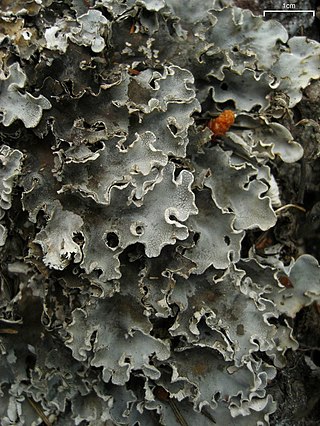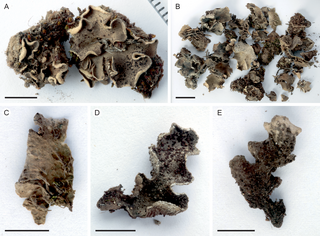
Peltigera is a genus of approximately 100 species of foliose lichens in the family Peltigeraceae. Commonly known as the dog or pelt lichens, species of Peltigera are often terricolous, but can also occur on moss, trees, rocks, and many other substrates in many parts of the world.

Peltigerales is an order of lichen-forming fungi belonging to the class Lecanoromycetes in the division Ascomycota. The taxonomy of the group has seen numerous changes; it was formerly often treated as a suborder of the order Lecanorales. It contains two suborders, eight families and about 45 genera such as Lobaria and Peltigera.

Sticta is a genus of lichens in the family Peltigeraceae. The genus has a widespread distribution, especially in tropical areas, and includes about 114 species. These lichens have a leafy appearance, and are colored brown or black. Sticta species with cyanobacteria as photobionts can fix nitrogen from the atmosphere, and due to their relative abundance and high turnover, they contribute appreciably to the rainforest ecosystem. They are commonly called spotted felt lichens.

The Arctomiaceae are a family of lichenized fungi in the Ascomycota, class Baeomycetales. The family was named by Theodor Magnus Fries in 1861, with Arctomia as the type genus. Species in this family are found in arctic and subarctic habitats, usually associated with bryophytes.
Orvo Vitikainen is a Finnish lichenologist. He entered the University of Helsinki in 1961, from where he obtained a Candidate of Philosophy degree in 1966, and a Licentiate of Philosophy in 1971. He later earned a Ph.D. from this institution in 1994, under the supervision of Teuvo Ahti. Between the years 1961 and 1981 he was a junior curator of cryptogams at the University of Helsinki Botanical Garden, and then from 1983 to 2004 he was the head of the lichen herbarium. Here he managed the internationally valuable collections of the early lichenologists Erik Acharius and William Nylander. He has collected thousands of specimens for the herbarium from various locations in Finland, but also internationally, including Sweden, Norway, Denmark, Russian Karelia, Scotland, Austria, Italy, Hungary, Croatia, Montenegro, Tanzania, Kenya, British Columbia, and Brazil. In 1992–1994, he was a scientist of the Finnish Academy in the Ahti research group.

Emmanuël Sérusiaux is a Belgian lichenologist. His career, spanning more than four decades, has combined both lichenology research and political aspects of nature conservation. He spent several periods working as a researcher at the National Fund for Scientific Research and the University of Liège, the latter in which he accepted a faculty position as professor and head of the Plant Taxonomy and Conservation Biology unit. Sérusiaux also served for three non-consecutive appointments as Deputy Chief of Staff in the Government of Wallonia. He retired from both his academic and political positions in 2019.
Peltigera serusiauxii is a species of foliose lichen in the family Peltigeraceae. It is found in Papua New Guinea and Sabah, northern Borneo (Malaysia). It was described as a new species in 2020 by Nicolas Magain, Jolanta Miadlikowska, Bernard Goffinet, and Antoine Simon. The type was collected in Mount Gahavisuka Provincial Park, where it was found growing in a mostly undisturbed mossy mountain forest dominated by chinquapin trees. The specific epithet honours Belgian lichenologist Emmanuël Sérusiaux, "who substantially contributed to our understanding of the world-wide diversity of Peltigera, especially in Papua New Guinea where he collected the type material among several other specimens of this new species".
Peltigera papuana is a lichen-forming fungus in the family Peltigeraceae. It was described in 2009 from Madang Province of Papua New Guinea, which inspired its specific epithet. Genetic analysis of both the mycobiont and the photobiont, which is a Nostoc cyanobacterium, suggests that the evolutionary origin of Pelitgera papuana is from an ancient dispersal event from South America, although this remains inconclusive.

Peltigera rufescens, the field dog lichen or field pelt, is a species of terricolous (ground-dwelling), foliose lichen in the family Peltigeraceae. The common and widespread species has a cosmopolitan distribution. The lichen has a surface that is densely covered with a soft, velvety layer, extending from the edges to the centre. The edges of this lichen typically curl upwards, revealing lobes that can be up to 10 millimetres wide. Beneath, it possesses a network of rhizines, which are root-like structures that merge together into a thick mat, anchoring the lichen to its substrate.
Peltigera wulingensis is a species of terricolous (ground-dwelling), foliose lichen in the family Peltigeraceae. Originally described from specimens found in northern China, it has since been recorded in Canada, Norway, and Russia.
Peltigera fimbriata is a species of foliose lichen in the family Peltigeraceae. Found in Papua New Guinea, it was formally described as a new species in 2009 by lichenologists Orvo Vitikainen, Emmanuël Sérusiaux, Bernard Goffinet, and Jolanta Miądlikowska. The type specimen was collected between Mt. Sarawaket Southern Range and Iloko village The species epithet fimbriata refers to the characteristic long hairs that occur on the upper thallus surface.
Peltigera granulosa is a species of terricolous (ground-dwelling), foliose lichen in the family Peltigeraceae. Found in Papua New Guinea, it was formally described as a new species in 2009 by Emmanuël Sérusiaux, Bernard Goffinet, Jolanta Miądlikowska, and Orvo Vitikainen. The type specimen was collected from open grassland between Gumum and Sape villages, where it was found growing on sand. The species epithet granulosa refers to its characteristic granulose margin.
Peltigera koponenii is a species of foliose lichen in the family Peltigeraceae. Found in Papua New Guinea, it was formally described as a new species in 2009 by Emmanuël Sérusiaux, Bernard Goffinet, Jolanta Miądlikowska, and Orvo Vitikainen. The type specimen was collected near Lake Wanba at an altitude of 2,400–2,500 m (7,900–8,200 ft), where it was found growing on a tree trunk in an open montane forest of Nothofagus and Pandanus. The species epithet honours Finnish bryologist Timo Koponen, "who made large and well processed collections of Peltigera in Papua New Guinea".
Peltigera montis-wilhelmii is a rare species of corticolous (bark-dwelling), foliose lichen in the family Peltigeraceae. Found in Papua New Guinea, it was formally described as a new species in 2009 by Emmanuël Sérusiaux, Bernard Goffinet, Jolanta Miądlikowska, and Orvo Vitikainen. The type specimen was collected from Pindaunde valley on Mount Wilhelm at an altitude of 3,600 m (11,800 ft). The species epithet refers to the type locality.
Peltigera weberi is a rare species of foliose lichen in the family Peltigeraceae. It is found in Papua New Guinea, where it grows on road banks and on earth and rock debris.

Gabura borbonica, previously known as Arctomia borbonica, is a species of foliose lichen found on Réunion, an island in the Mascarene archipelago. This species is unique due to its distinct features such as a crumpled, blue-grey to brown thallus and the production of structures called goniocysts at its margins. G. borbonica was transferred to the genus Gabura in 2020, and is distinguished from its sister species, Gabura insignis, both genetically and morphologically.

Peltigera hydrophila is a species of foliose lichen in the family Peltigeraceae. First described in 2020, it distinguishes itself through a distinct, hairless thallus that turns deep blue-violet when it becomes wet. Found primarily in the Magallanes Region of Chile, this small leafy lichen clings closely to mosses and other substrates. Distinctive features include the always-present reddish-brown to dark brown apothecia and the Peltigera-type ascospores that contain three internal partitions, or septa. Despite sharing a habitat with similar species like P. aubertii and P. frigida, P. hydrophila sets itself apart through its unique thallus surface texture and colour. This semi-aquatic lichen primarily thrives in humid forests, shrubby and herbaceous vegetation in southern Chile, particularly near waterfalls, streams, and other wet environments.

Peltigera cinnamomea, commonly known as the dog pelt or cinnamon-pelt lichen, is a muscicolous (moss-dwelling), foliose lichen in the family Peltigeraceae. Canadian lichenologist Trevor Goward formally described the species in 1995. The lichen is found in northwestern North America's forested regions, particularly in the unique montane and subalpine forest communities of the northern Rocky Mountains. Peltigera cinnamomea grows under prolonged snow cover, surviving well into spring. This trait distinguishes it from many other Peltigera species in similar North American forest ecosystems.

Peltigera castanea is a species of terricolous and muscicolous, foliose lichen in the family Peltigeraceae. Described as a new species in 2003, it is part of the taxonomically challenging species complex centred around Peltigera didactyla. Recognised based on phylogenetic studies that highlighted its unique genetic markers, P. castanea is distinguished by its dark, chestnut-coloured upper surface, which inspired its vernacular name, chestnut pelt lichen. Its known distribution includes North America, Asia, Europe (Estonia), Greenland, and the Antarctic. The conservation status of Peltigera castanea varies regionally, from being critically imperiled in British Columbia and Yukon to critically endangered in Estonia due to significant habitat degradation and restricted population size.

Peltigera alkalicola is a rare species of terricolous (ground-dwelling) foliose lichen in the family Peltigeraceae. First described in 2022 from specimens collected in the Kilimanjaro National Park in Tanzania, it is characterised by its unique ecological preferences. Analysis of DNA samples indicate that the lichen may also occur in Alaska, USA, and Ningxia, China, suggesting a wider distribution in cold, montane ecosystems.










